Indrakshi Dey
Classical Capacity of Arbitrarily Distributed Noisy Quantum Channels
Jun 28, 2023Abstract:With the rapid deployment of quantum computers and quantum satellites, there is a pressing need to design and deploy quantum and hybrid classical-quantum networks capable of exchanging classical information. In this context, we conduct the foundational study on the impact of a mixture of classical and quantum noise on an arbitrary quantum channel carrying classical information. The rationale behind considering such mixed noise is that quantum noise can arise from different entanglement and discord in quantum transmission scenarios, like different memories and repeater technologies, while classical noise can arise from the coexistence with the classical signal. Towards this end, we derive the distribution of the mixed noise from a classical system's perspective, and formulate the achievable channel capacity over an arbitrary distributed quantum channel in presence of the mixed noise. Numerical results demonstrate that capacity increases with the increase in the number of photons per usage.
Wavelet Packet Division Multiplexing (WPDM)-Aided Industrial WSNs
May 28, 2023



Abstract:Industrial Internet-of-Things (IIoT) involve multiple groups of sensors, each group sending its observations on a particular phenomenon to a central computing platform over a multiple access channel (MAC). The central platform incorporates a decision fusion center (DFC) that arrives at global decisions regarding each set of phenomena by combining the received local sensor decisions. Owing to the diverse nature of the sensors and heterogeneous nature of the information they report, it becomes extremely challenging for the DFC to denoise the signals and arrive at multiple reliable global decisions regarding multiple phenomena. The industrial environment represents a specific indoor scenario devoid of windows and filled with different noisy electrical and measuring units. In that case, the MAC is modelled as a large-scale shadowed and slowly-faded channel corrupted with a combination of Gaussian and impulsive noise. The primary contribution of this paper is to propose a flexible, robust and highly noise-resilient multi-signal transmission framework based on Wavelet packet division multiplexing (WPDM). The local sensor observations from each group of sensors are waveform coded onto wavelet packet basis functions before reporting them over the MAC. We assume a multi-antenna DFC where the waveform-coded sensor observations can be separated by a bank of linear filters or a correlator receiver, owing to the orthogonality of the received waveforms. At the DFC we formulate and compare fusion rules for fusing received multiple sensor decisions, to arrive at reliable conclusions regarding multiple phenomena. Simulation results show that WPDM-aided wireless sensor network (WSN) for IIoT environments offer higher immunity to noise by more than 10 times over performance without WPDM in terms of probability of false detection.
IoT Localization and Optimized Topology Extraction Using Eigenvector Synchronization
May 28, 2023Abstract:Internet-of-Things (IoT) devices are low size, weight and power (SWaP), low complexity and include sensors, meters, wearables and trackers. Transmitting information with high signal power is exacting on device battery life, therefore an efficient link and network configuration is absolutely crucial to avoid signal power enhancement in interference-rich environment and resorting to battery-life extending strategies. Efficient network configuration can also ensure fulfilment of network performance metrics like throughput, coding rate and spectral efficiency. We formulate a novel approach of first localizing the IoT nodes and then extracting the network topology for information exchange between the nodes (devices, gateway and sinks), such that overall network throughput is maximized. The nodes are localized using noisy measurements of a subset of Euclidean distances between two nodes. Realizable subsets of neighboring devices agree with their own position within the entire network graph through eigenvector synchronization. Using communication global graph-model-based technique, network topology is constructed in terms of transmit power allocation with the aim of maximizing spatial usage and overall network throughput. This topology extraction problem is solved using the concept of linear programming.
Transmit Power Optimization of IoT Devices over Incomplete Channel Information
May 27, 2023Abstract:Efficient resource allocation (RA) strategies within massive and dense Internet of Things (IoT) networks is one of the major challenges in the deployment of IoT-network based smart ecosystems involving heterogeneous power-constrained IoT devices operating in varied radio and environmental conditions. In this paper, we focus on the transmit power minimization problem for IoT devices while maintaining a threshold channel throughput. The established optimization literature is not robust against the fast-fading channel and the interaction among different transmit signals in each instance. Besides, realistically, each IoT node possesses incomplete channel state information (CSI) on its neighbors, such as the channel gain being private information for the node itself. In this work, we resort to Bayesian game theoretic strategies for solving the transmit power optimization problem exploiting incomplete CSIs within massive IoT networks. We provide a steady discussion on the rationale for selecting the game theory, particularly the Bayesian scheme, with a graphical visualization of our formulated problem. We take advantage of the property of the existence and uniqueness of the Bayesian Nash equilibrium (BNE), which exhibits reduced computational complexity while optimizing transmit power and maintaining target throughput within networks comprised of heterogeneous devices.
Mathematical Model of Quantum Channel Capacity
Feb 16, 2023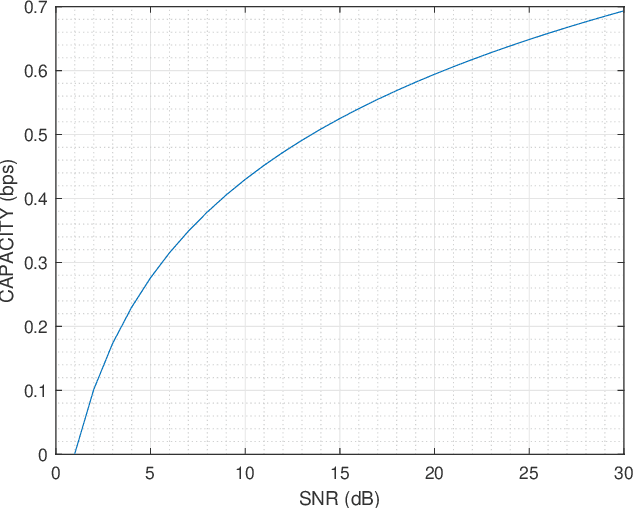
Abstract:In this article, we are proposing a closed-form solution for the capacity of the single quantum channel. The Gaussian distributed input has been considered for the analytical calculation of the capacity. In our previous couple of papers, we invoked models for joint quantum noise and the corresponding received signals; in this current research, we proved that these models are Gaussian mixtures distributions. In this paper, we showed how to deal with both of cases, namely (I)the Gaussian mixtures distribution for scalar variables and (II) the Gaussian mixtures distribution for random vectors. Our target is to calculate the entropy of the joint noise and the entropy of the received signal in order to calculate the capacity expression of the quantum channel. The main challenge is to work with the function type of the Gaussian mixture distribution. The entropy of the Gaussian mixture distributions cannot be calculated in the closed-form solution due to the logarithm of a sum of exponential functions. As a solution, we proposed a lower bound and a upper bound for each of the entropies of joint noise and the received signal, and finally upper inequality and lower inequality lead to the upper bound for the mutual information and hence the maximum achievable data rate as the capacity. In this paper reader will able to visualize an closed-form capacity experssion which make this paper distinct from our previous works. These capacity experssion and coresses ponding bounds are calculated for both the cases: the Gaussian mixtures distribution for scalar variables and the Gaussian mixtures distribution for random vectors as well.
Quantum Channel Modelling by Statistical Quantum Signal Processing
Feb 16, 2023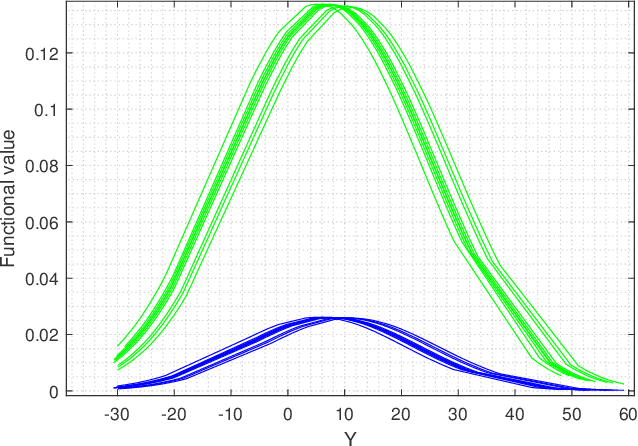
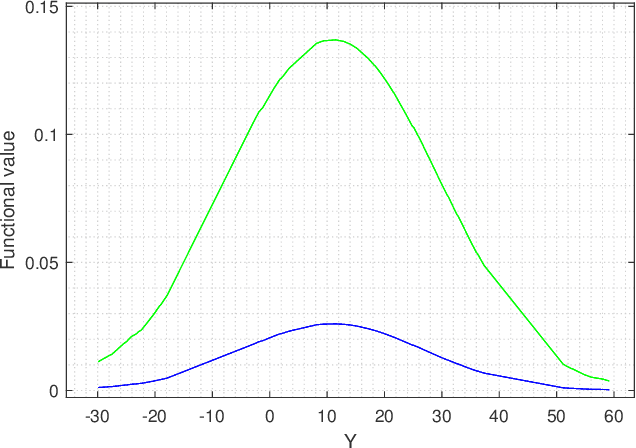
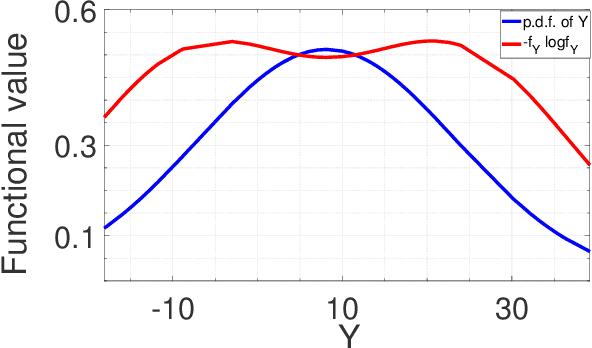
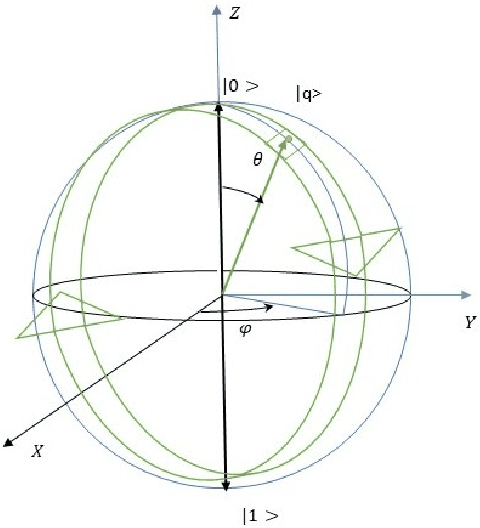
Abstract:In this paper we are interested to model quantum signal by statistical signal processing methods. The Gaussian distribution has been considered for the input quantum signal as Gaussian state have been proven to a type of important robust state and most of the important experiments of quantum information are done with Gaussian light. Along with that a joint noise model has been invoked, and followed by a received signal model has been formulated by using convolution of transmitted signal and joint quantum noise to realized theoretical achievable capacity of the single quantum link. In joint quantum noise model we consider the quantum Poisson noise with classical Gaussian noise. We compare the capacity of the quantum channel with respect to SNR to detect its overall tendency. In this paper we use the channel equation in terms of random variable to investigate the quantum signals and noise model statistically. These methods are proposed to develop Quantum statistical signal processing and the idea comes from the statistical signal processing.
Joint Modelling of Quantum and Classical Noise over Unity Quantum Channel
Jun 08, 2022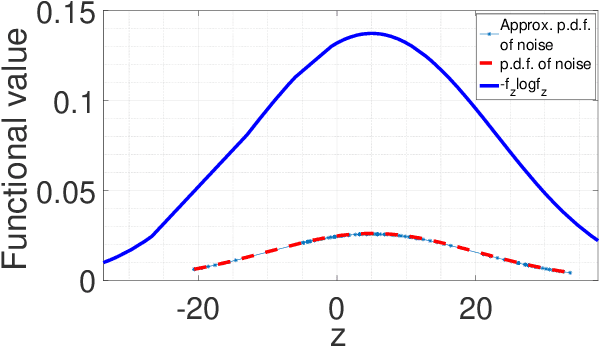
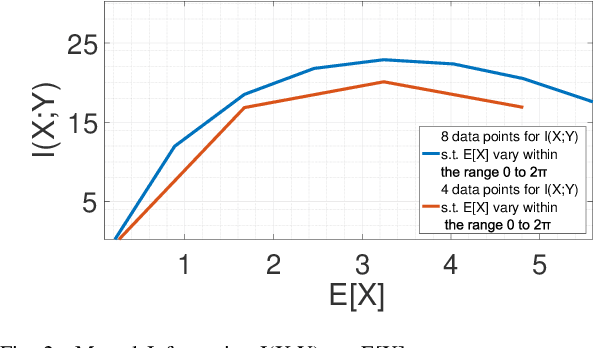
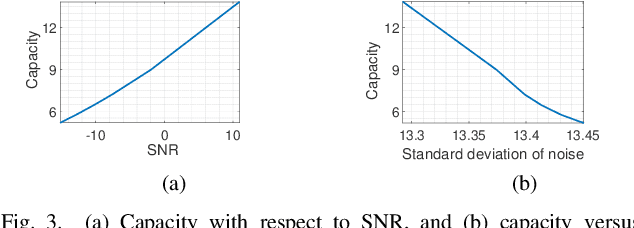
Abstract:For a continuous-input-continuous-output arbitrarily distributed quantum channel carrying classical information, the channel capacity can be computed in terms of the distribution of the channel envelope, received signal strength over a quantum propagation field and the noise spectral density. If the channel envelope is considered to be unity with unit received signal strength, the factor controlling the capacity is the noise. Quantum channel carrying classical information will suffer from the combination of classical and quantum noise. Assuming additive Gaussian-distributed classical noise and Poisson-distributed quantum noise, we formulate a hybrid noise model by deriving a joint Gaussian- Poisson distribution in this letter. For the transmitted signal, we consider the mean of signal sample space instead of considering a particular distribution and study how the maximum mutual information varies over such mean value. Capacity is estimated by maximizing the mutual information over unity channel envelope.
Modelling Underwater Acoustic Propagation using One-way Wave Equations
Feb 14, 2022Abstract:The primary contribution of this paper is to characterize the propagation of acoustic signal carrying information through any medium and the interaction of the travelling acoustic signal with the surrounding medium. We will use the concept of damped harmonic oscillator to model the medium and Milne's oscillator technique to map the interaction of the acoustic signal with the medium. The acoustic signal itself will be modelled using the one-way wave equation formulated in terms of acoustic pressure and velocity of acoustic waves through the medium. Using the above-mentioned concepts, we calculated the effective signal strength, phase shift and time period of the communicated signal. Numerical results are generated to present the evolution of signal strength and received signal envelope in underwater environment.
A Nano-Architecture for Fertility Monitoring via Intra-body Communication
Feb 04, 2022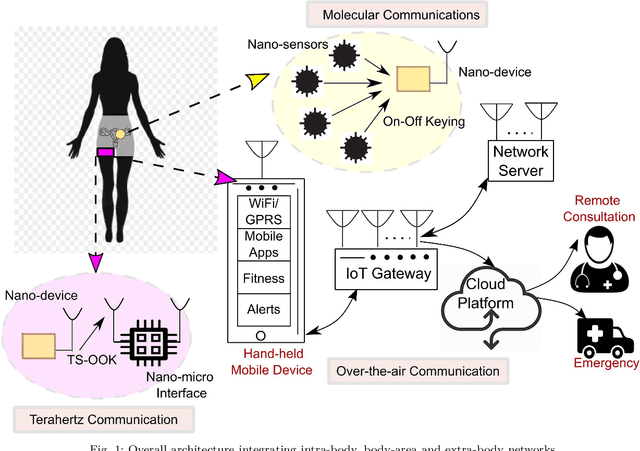
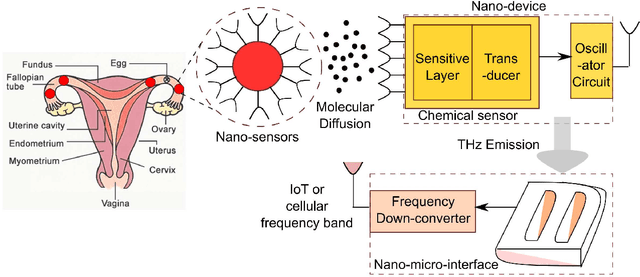
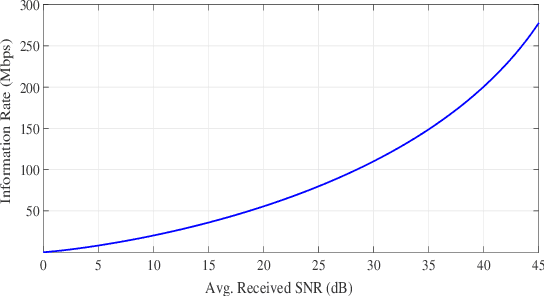
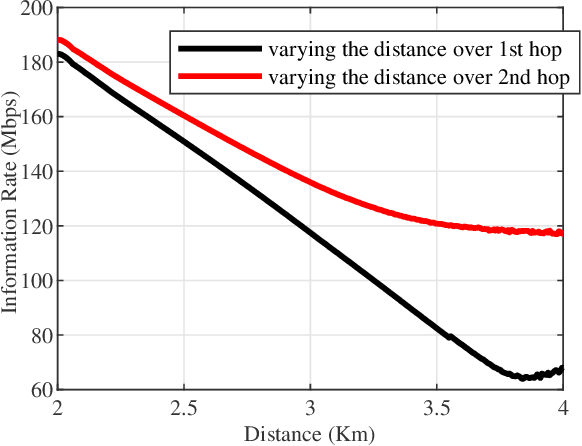
Abstract:Fertility monitoring in humans for either natural conception or artificial insemination and fertilization has been a critical challenge both for the treating physician and the treated patients. Eggs in human female can be fertilized when they reach the Fallopian tube from the upper parts of the reproductive system. However, no technology, till date, on its own could detect the presence of eggs in the Fallopian tube and communicate their presence to the consulting physician or nurse and the patient, so that the next step can be initiated in a timely fashion. In this paper, we propose a conceptual architecture from a communications engineering point of view. The architecture combines intra-body nano-sensor network for detecting Fallopian tube activity, with body-area network for receiving information from the intra-body network and communicating the same over-the-air to the involved personnel (physician/nurse/patient). Preliminary simulations have been conducted using particle based stochastic simulator to investigate the relationship between achievable information rates, signal to noise ratio (SNR) and distance. It has been found that data rate as high as 300 Mbps is achievable at SNR 45. Hence, the proposed architecture ensures transfer of information with near-zero latency and minimum energy along with high throughput, so that necessary action can be taken within the short time-window of the Fallopian tube activity.
Modelling Quantum Channels Carrying Classical Information
Dec 05, 2021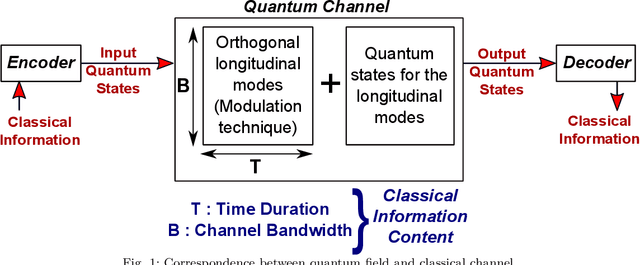
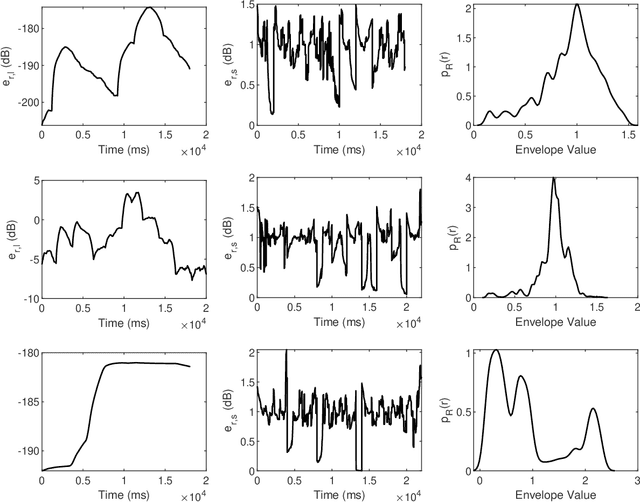
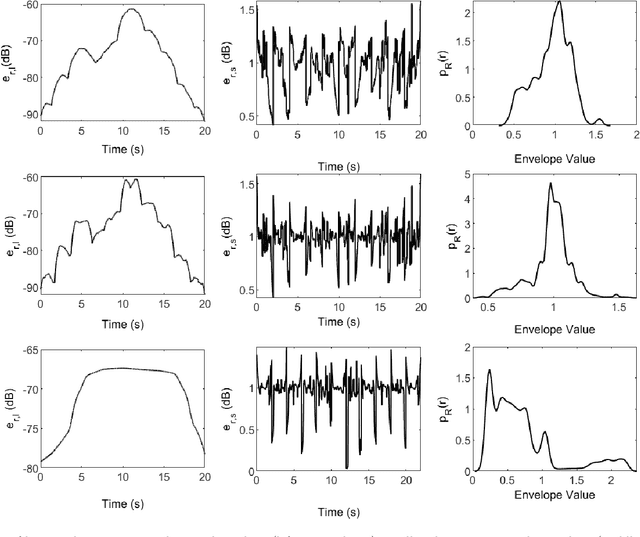
Abstract:We use the concept of coupled quantum harmonic oscillators to model the propagation environment in which a quantum link carrying either classical or quantum information operates. Using the analogy between the paraxial optical wave equation and the stationary Schrodinger equation and applying the Caldirola-Kanai Hamiltonian for solving the time-dependent Schrodinger equation; we calculate the propagation field strength and the corresponding average received signal energy.
 Add to Chrome
Add to Chrome Add to Firefox
Add to Firefox Add to Edge
Add to Edge